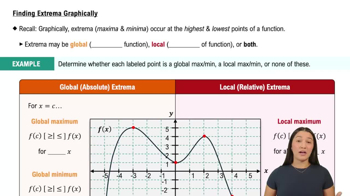Table of contents
- 0. Functions7h 52m
- Introduction to Functions16m
- Piecewise Functions10m
- Properties of Functions9m
- Common Functions1h 8m
- Transformations5m
- Combining Functions27m
- Exponent rules32m
- Exponential Functions28m
- Logarithmic Functions24m
- Properties of Logarithms34m
- Exponential & Logarithmic Equations35m
- Introduction to Trigonometric Functions38m
- Graphs of Trigonometric Functions44m
- Trigonometric Identities47m
- Inverse Trigonometric Functions48m
- 1. Limits and Continuity2h 2m
- 2. Intro to Derivatives1h 33m
- 3. Techniques of Differentiation3h 18m
- 4. Applications of Derivatives2h 38m
- 5. Graphical Applications of Derivatives6h 2m
- 6. Derivatives of Inverse, Exponential, & Logarithmic Functions2h 37m
- 7. Antiderivatives & Indefinite Integrals1h 26m
- 8. Definite Integrals4h 44m
- 9. Graphical Applications of Integrals2h 27m
- 10. Physics Applications of Integrals 2h 22m
5. Graphical Applications of Derivatives
Intro to Extrema
Problem 4.1.71
Textbook Question
Suppose the position of an object moving horizontally after seconds is given by the function s(t) = 32t - t⁴, where 0 ≤ t ≤ 3 and s is measured in feet, with s > 0 corresponding to positions to the right of the origin. When is the object farthest to the right?
 Verified step by step guidance
Verified step by step guidance1
To find when the object is farthest to the right, we need to determine the maximum value of the position function s(t) = 32t - t^4 over the interval 0 ≤ t ≤ 3.
First, find the derivative of the position function, s'(t), to determine the critical points. The derivative is s'(t) = 32 - 4t^3.
Set the derivative equal to zero to find the critical points: 32 - 4t^3 = 0. Solve for t to find the critical points.
Evaluate the position function s(t) at the critical points and at the endpoints of the interval, t = 0 and t = 3, to determine which gives the maximum value.
Compare the values of s(t) at these points to determine when the object is farthest to the right. The largest value of s(t) will indicate the time when the object is farthest to the right.
 Verified video answer for a similar problem:
Verified video answer for a similar problem:This video solution was recommended by our tutors as helpful for the problem above
Video duration:
2mPlay a video:
Was this helpful?
Key Concepts
Here are the essential concepts you must grasp in order to answer the question correctly.
Position Function
The position function s(t) describes the location of an object at any given time t. In this case, s(t) = 32t - t⁴ represents the position of an object moving horizontally, where t is measured in seconds and s in feet. Understanding this function is crucial for determining the object's position over time and analyzing its motion.
Recommended video:

Relations and Functions
Critical Points
Critical points occur where the derivative of a function is zero or undefined. To find when the object is farthest to the right, we need to calculate the derivative of the position function, s'(t), and set it equal to zero. This helps identify potential maximum positions within the given interval.
Recommended video:

Critical Points
Second Derivative Test
The second derivative test is a method used to determine the concavity of a function at critical points. By evaluating the second derivative, s''(t), we can ascertain whether a critical point is a local maximum, minimum, or neither. This is essential for confirming that the object is indeed at its farthest right position when the first derivative is zero.
Recommended video:

The Second Derivative Test: Finding Local Extrema

 5:58m
5:58mWatch next
Master Finding Extrema Graphically with a bite sized video explanation from Callie
Start learning





